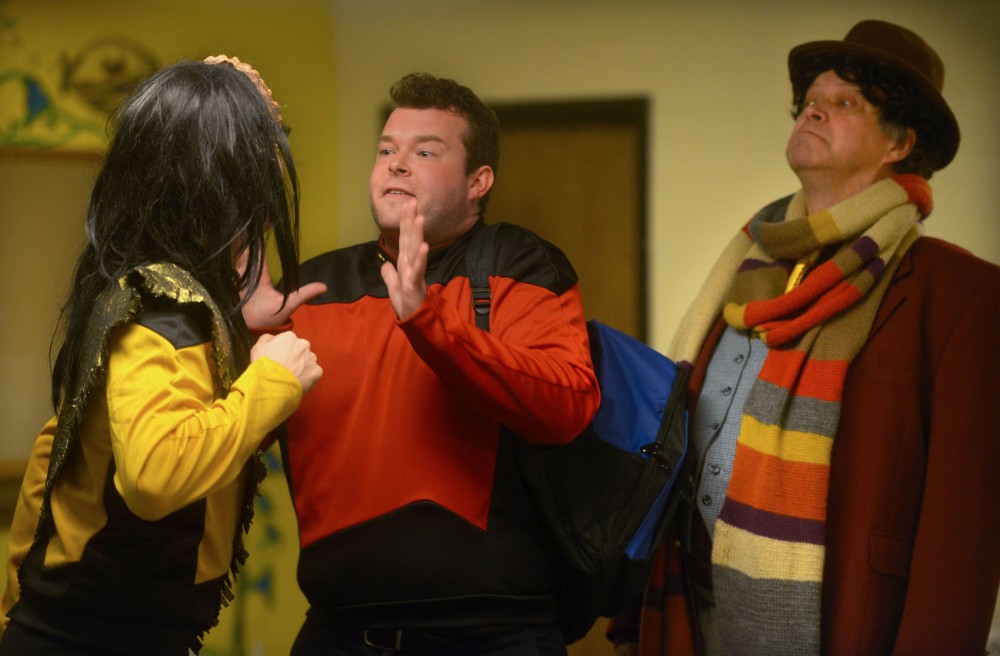Since 1994, the Minnesota Fringe Festival has offered a staggering amount of theater over its annual 11-day run. With 176 shows in 16 venues, the largest non-juried theater festival in the United States offers an unpredictable slew this year.
Choosing what 60-minute shows to attend is a tricky task, but fortunately A&E scouted out the top comedies among the wide-ranging line-up of productions. From a tribute to the cult fandom of “Star Trek” to one man’s trek in the Sahara, these three shows offer a diverse array of humor.
Inside Trek
“Stuck in an Elevator with Patrick Stewart”
Where: Red Eye Theater, 15 14th St. W., Minneapolis
When:

7 p.m., Saturday; 8:30 p.m., Sunday; 10 p.m., Tuesday; 5:30 p.m., August 9 and 8:30 p.m., August 10
Bill Hedrick is fluent in Klingon. When asked whether actor Phillip Schramm mastered the fake language popularized on “Star Trek,” the makeup artist balked.
In response to Hedrick’s silent disproval of his Klingon-speaking abilities, Schramm, who plays a Trekkie, simply shrugged.
“I’m young. I have time,” he joked.
Luckily, “Stuck in an Elevator with Patrick Stewart” requires no proficiency in the fictional alien language. Writer Brandon Taitt’s Fringe premiere may trade in steep references from the cult TV show, but the story gives a universal account of hero-worship.
“Stuck in an Elevator” follows a group of devoted Trekkies at a science fiction convention in 1988. When the 17-year-old Daniel finds himself stuck with his hero, the star of “Star Trek: The Next Generation,” he gushes over his idol.
“Daniel isn’t seeing Patrick Stewart,” Taitt said. “He’s seeing Captain Picard.”
In the early days of “The Next Generation,” the classically-trained British actor wanted nothing to do with “Star Trek” after the reboot’s first season.
“He felt he had made this big mistake,” Taitt said. “At the time, he was very displeased with his role.”
Stewart initially felt antagonistic with a whole cadre of overzealous fans — none of them cared about his love of “Hamlet” or “The Merchant of Venice.” Basing much of Stewart’s objections to the show on his biography, Taitt soon found parallels in the actor’s biography and the fantasies of many Trekkies.
“He lived in a very violent household — not something you’d expect from him,” Taitt said. “He used theater as an escape to get away from that world at home.”
Thus, the escapism that Daniel finds in “Star Trek” becomes common ground in the show. “Stuck in an Elevator” finds the two diametrically opposed strangers bonding unexpectedly.
Underneath bright starship regalia, Taitt’s comedy reveals rich depiction of devoted “Star Trek” followers. None of the actors trade in the stereotypes found on “The Big Bang Theory” because they’re fully fleshed out.
“So they’re not just about pretending to be a Klingon or pretending to be Spock,” director Kevin T. Houle said. “They’re real people.”
The same way “Star Trek” unites fans with an endearing optimism, “Stuck in an Elevator” paints its Trekkie characters as human.
One-hit wander
“Wanderlust”“
Where: University of Minnesota, Rarig Center Thrust, 330 21st Ave. S., Minneapolis
When:
7 p.m., Friday; 4 p.m., Sunday; 5:30 p.m., Monday; 8:30 p.m., Tuesday and 7 p.m., August 11
Martin Dockery knew he had the beginning of a great story. In the middle of the Sahara desert, he met a Belgian couple on their way to Timbuktu, Mali.
The only thing in the way for the trio’s trek across the desert in a Land Rover: a food shortage or flat tire — anything to heighten the drama.
“I thought, ‘all we need is for something to happen,’”****** Dockery said.
The one-man show “Wanderlust” follows his autobiographical account through West Africa, but he never found a “Heart of Darkness” type of tragedy, as much as Dockery initially wanted.
“The show’s about waiting for that amazing thing to happen,” Dockery said.
In 2004, the Brooklyn storyteller embarked on the backpacking trip in need of adventure. When he returned six months later, he wanted to translate his tales into an account reflecting his own state of mind.
“Wanderlust” reflects Dockery’s gifted comic sense — he performs the show without a script, insisting that the account feels extemporaneous to crowds with each pass.
“I had this idea that I wanted to go to somewhere faraway,” Dockery said. “Timbuktu is this place that we grow up hearing as the most faraway place you can go — it’s not too far away for the people who live there.”
The comedic situations Dockery highlights in “Wanderlust” sometimes reveal the foreigner’s naivety — over the course of the play, Dockery learns to accept his story. While his tale of Mali included no truly dramatic elements, he learned to appreciate the small moments of his journey.
Throughout his career in wandering from backpacking trips in Asia and Africa, Dockery’s now made his travels fodder for insightful comedy. “Wanderlust” represents his breakthrough as the performer, who recognizes that he’s deeply embedded in the story even if sometimes he doesn’t realize it.
Silent sci-fi
“To Mars with Tesla or the Interplanetary Machinations of Evil Thomas Edison”
Where: Intermedia Arts, 2822 Lyndale Ave. S., Minneapolis
When:
7 p.m., Sunday; 5:30 p.m., Tuesday; 5:30 p.m., August 7; 8:30 p.m., August 9 and 4 p.m., August 10
J. Weldon Cobb’s 1901 novella “To Mars with Tesla” features very little interstellar travel. The pulp sci-fi story instead features ray gun-toting gangsters — in other words, Joshua English Scrimshaw used the book’s title for his Fringe show because its source material makes no sense.
Originally produced for Open Eye Figure Theater as part of “Steampunk Delusions,” Scrimshaw wrote the silent comedy “To Mars with Tesla” in hopes of rewriting a ridiculous history in the tradition of the genre.
“[It’s] taking characters from history and spinning fantastical alternate versions of them — often casting forgotten people as heroes,” Scrimshaw said.
Nikola Tesla, the real-life electrical engineer who worked for Thomas Edison, becomes the hero in “To Mars with Tesla.” Scrimshaw plays the heroic scientist as he silently travels to the red planet.
Scrimshaw and company create a living silent movie in the vein of a Buster Keaton comedy. Scored by Miriam Gerberg, a rollicking piano is the only sound that accompanies the physical gags.
“There are a lot of classic radium gags, too,” Scrimshaw said, referring to chemist Marie Curie’s role in the story.
Although no knowledge of the historical figures is required, the factual jokes heighten the comedy. One of the opening projected slides reveals the textual humor at play, relying on a fact from Tesla’s life.
“We play a lot on Tesla’s weird side,” Scrimshaw said. “He had a weird revulsion of human hair and he wasn’t really into women.”
“To Mars with Tesla” might have some of the most obscure Fringe references, but also some of the setup’s the most accessible comedy — the pseudo history only deepens the fantasy.









